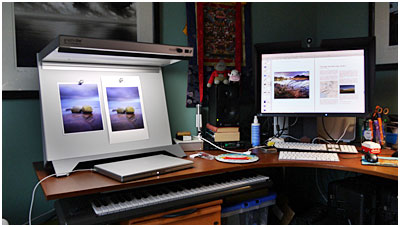For those of you who’ve been reading my blog for a while now, you’ll know I spent a bit of time last year getting a good colour managed system in my studio. Last year I bought an Epson 4880 printer and Colourbursts RIP driver. I also bought a viewing booth, which is vital in allowing me to assess and review my prints under daylight balanced light.

So my colour management was going really nicely, until my screen calibration tool broke. My trusty old Gretag Macbeth Eye One (now Xrite) started to produce wildly varying profiles, and after evaluating it on a friends system, I quickly came to the conclusion that it was broken, which probably explains why it went into the bin last year.
It’s an admission I’m not comfortable making, but I feel I must. Since last October, I’ve not been able to calibrate my screen. This might sound like terrible news.... how can Bruce work on his images if his screen is way out? Well, the simple answer is that I was able to confirm that my screen wasn’t ‘way out’. In fact, it turns out that my screen, when set to default settings was pretty much ‘way in’. Let me explain.
I’ve got an Eizo CG241W display at home. It comes from the factory calibrated. I hadn’t realised just how well calibrated it is in 'factory-mode' until I evaluated it whilst using a calibration test target. The test target comes in two parts - the first part is a TIFF file you open up in Photoshop, while the other part is a printed file, that when put under the viewing booth I own. If the TIFF file is opened up and the correct proofing setting enabled, both the printed file and the electronic one *should* look very similar. Well, it turns out that my test target looks pretty damn close when my Eizo is set to default settings. So this is how I was able to work for the past six months without a display calibrator.
To be fair, evaluating a printed target against one loaded up in Photoshop with proofing enabled is really the only way to ensure your calibration is true or 'close'.
But I have to confess that good is never good enough. I’m a perfectionist, and if there’s any chance of error in what I’m seeing on my display, it does make me feel a little uneasy. So I’d had my eyes on a new screen calibration tool for some time.
Enter the BasICColour Discus. I’d read so many review of it, seen it calibrate screens much tighter than anything else on the market - I knew I had to have one. But it’s not cheap, coming in at around £850. Yep, that’s around four times the price of an Xrite i1 Pro, which has similar features.
I felt that since I was getting ready to prepare my Iceland images for my 2nd book, I should really invest in a decent screen calibrator, and well, I must confess - I was sold on the Discus. Sometimes, I’m attracted to something because there’s an element of gear-lust involved (as much as I hate to admit that I'm susceptible, just like anyone else is to being attracted to some piece of gear), and in the case of the Discus, it’s a beautifully crafted piece of engineering. It reeks quality. But is it any good?
 Well, I’m not really going to give you any deep technical reviews of the Discus, but suffice to say that although the calibrations are very accurate, they’re not as tight as the reviews I read before purchase. Do I feel deflated? A little, yes. But I think overall I’m happy, because the Discus is a quality piece of solid engineering. I'm just curious as to whether it was worth the 4 times the price tag of an Xrite i1 pro though.
Well, I’m not really going to give you any deep technical reviews of the Discus, but suffice to say that although the calibrations are very accurate, they’re not as tight as the reviews I read before purchase. Do I feel deflated? A little, yes. But I think overall I’m happy, because the Discus is a quality piece of solid engineering. I'm just curious as to whether it was worth the 4 times the price tag of an Xrite i1 pro though.
So is there a message in this post for you all? Perhaps. I guess it's very easy to be swayed over by 'expensive = better', when in fact, we all know, as I have always done, that so long as the tools do the job, the rest is really up to us.
Ultimately, I can now get on with the main task at hand, that being preparing my Iceland images for print in my second book.
Tools are jumping boards to help us convey what our vision is, they are a means to an end. Do I wish I'd bought an Xrite i1 pro? Maybe.... but I think when it comes to making sure that colour is accurate, I would have preferred the option to test both items to see how far different the profiles are, before sinking the money. That said, now that I've done the deed, the profiles out of the Discus are very good indeed, so I'm not that interested in wasting my valuable time by splitting hairs between calibration devices. That is a job for someone with some free time on their hands.


